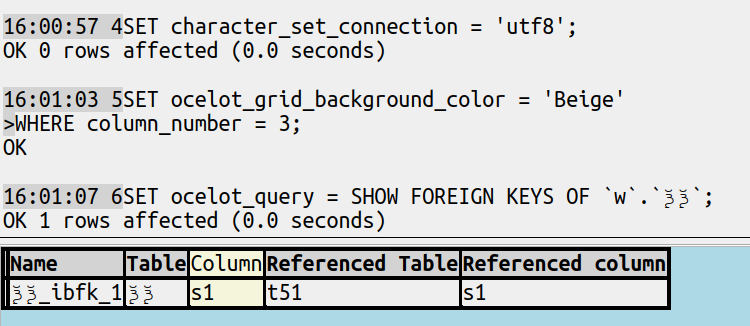Foreign Key Displays
For foreign keys, I like to see what references what, It’s easy to find but the challenge is to decide how to display.
The cute
Showing a result with the mysql client:
prompt> call show_fk('t2');
+-------------+-----------------+------------+
| referencing | constraint_name | referenced |
+-------------+-----------------+------------+
| t2 | mx | t3 |
| s1 | | s1 |
| s2 | | s2 |
| | | |
| t2 | t2_ibfk_1 | t1 |
| s1 | | s1 |
+-------------+-----------------+------------+
6 rows in set (0.08 sec)
Query OK, 6 rows affected (0.08 sec)
That is, for table T2, I show the table name and foreign-key name and referenced-table name, then the columns of that table in the order they appear in the foreign key, then if there is another foreign key repeat after a blank line.
Here is a long but simple stored procedure that produces such a display.
DROP PROCEDURE show_fk;
CREATE PROCEDURE show_fk(ref_table_name VARCHAR(128))
BEGIN
DECLARE d_table_name VARCHAR(128);
DECLARE d_column_name VARCHAR(128);
DECLARE d_ordinal_position INT;
DECLARE d_constraint_name VARCHAR(128);
DECLARE d_referenced_table_name VARCHAR(128);
DECLARE d_referenced_column_name VARCHAR(128);
DECLARE counter INT DEFAULT 0;
DECLARE err INT DEFAULT 0;
DECLARE x CURSOR FOR
SELECT table_name, column_name, ordinal_position,
constraint_name,
referenced_table_name, referenced_column_name
FROM information_schema.key_column_usage
WHERE table_name = ref_table_name AND referenced_column_name IS NOT NULL
ORDER BY constraint_name, ordinal_position;
DECLARE CONTINUE HANDLER FOR NOT FOUND SET err = 1;
DECLARE CONTINUE HANDLER FOR SQLEXCEPTION set err = 1;
CREATE TEMPORARY TABLE fks (referencing VARCHAR(128),
constraint_name VARCHAR(128),
referenced VARCHAR(128));
OPEN x;
WHILE err = 0 DO
FETCH x INTO d_table_name,d_column_name, d_ordinal_position,
d_constraint_name,
d_referenced_table_name, d_referenced_column_name;
IF err = 0 THEN
IF counter <> 0 AND d_ordinal_position = 1 THEN
INSERT INTO fks VALUES ('', '', '');
END IF;
IF d_ordinal_position = 1 THEN
INSERT INTO fks VALUES (d_table_name, d_constraint_name, d_referenced_table_name);
END IF;
INSERT INTO fks VALUES (d_column_name, '', d_referenced_column_name);
SET counter = counter + 1;
END IF;
END WHILE;
CLOSE x;
SELECT * FROM fks;
DROP TABLE fks;
END;
CALL show_fk('t2');
This is vaguely like an entity-relationship diagram, but with tables rather than pictures.
The flaws are: (1) it needs extra privileges, (2) it mixes different object types. So let’s look at the simpler and more common type of display.
The usual
Everything necessary can come from information_schema.key_column_usage.
For example, there’s a GUI that displays with these columns:
Name | Schema | Table | Column |Referenced Schema | Referenced Table | Referenced Column
That’s easy to reproduce with
SELECT constraint_name AS `Name`, table_schema AS `Schema`, table_name AS `Table`, column_name AS `Column`, referenced_table_schema AS `Referenced Schema`, referenced_table_name AS `Referenced Table`, referenced_column_name AS `Referenced Column` FROM information_schema.key_column_usage WHERE referenced_column_name IS NOT NULL ORDER BY constraint_name, ordinal_position;
Or if that takes too long to type, make a view.
There’s another GUI that displays with these columns:
Key name | Columns | Reference Table | Foreign Columns | On UPDATE | On DELETE
(The “On UPDATE” and “On DELETE” values would have to come from information_schema.referential_constraints.)
The objection that I’d make is that such headers are not standard. So anybody who knows the actual column names has to do a double take, wondering whether the first column is the same as “constraint_name” or something exotic, and so on. Use of multiple different names for the same thing is poetry not programming.
The new
So I think this display, which admittedly makes cosmetic changes (replacing ‘_’ with ‘ ‘ and changing upper case to mixed case and emphasizing one column) is better:

I’ve made it so that can come from user statements or from the explorer. The source code is downloadable now and the released executables will come soon.